Sidusglacies - ⚡️
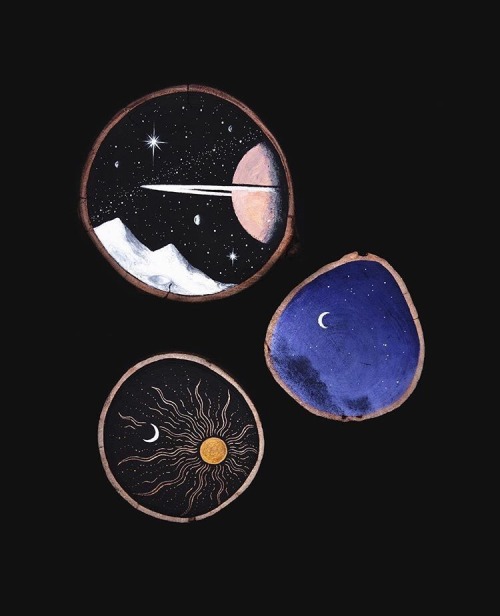
More Posts from Sidusglacies and Others











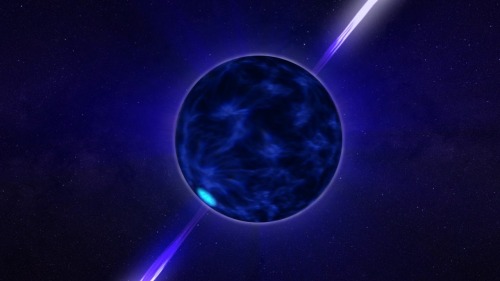
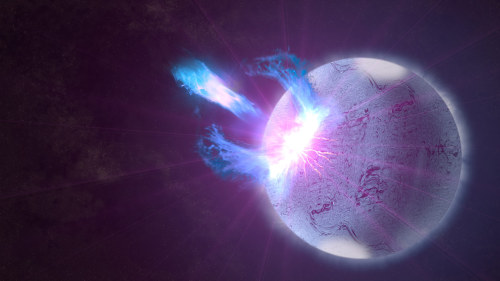
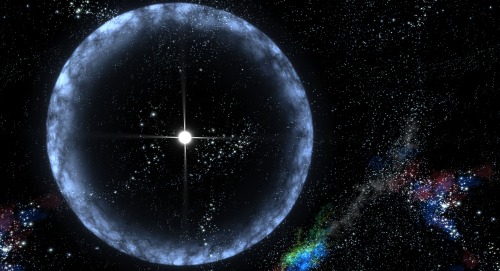
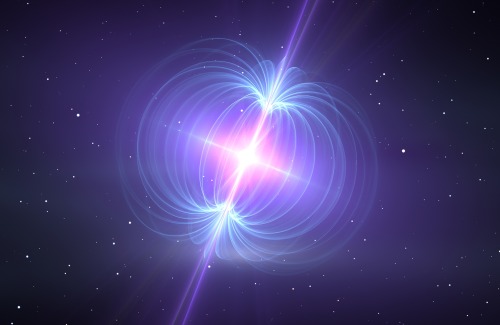
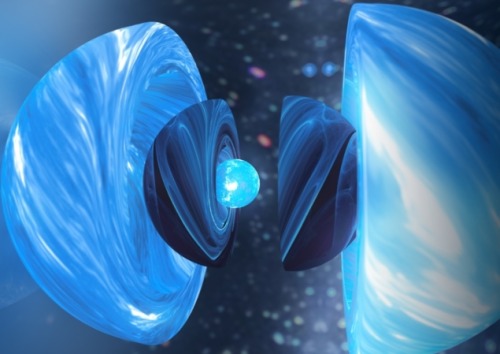
Starquakes
Sometimes a neutron star will undergo a glitch, a sudden small increase of its rotational speed or spin up. Glitches are thought to be the effect of a starquake—as the rotation of the neutron star slows, its shape becomes more spherical. Due to the stiffness of the “neutron” crust, this happens as discrete events when the crust ruptures, creating a starquake similar to earthquakes. After the starquake, the star will have a smaller equatorial radius, and because angular momentum is conserved, its rotational speed has increased.
Starquakes occurring in magnetars, with a resulting glitch, is the leading hypothesis for the gamma-ray sources known as soft gamma repeaters.
Recent work, however, suggests that a starquake would not release sufficient energy for a neutron star glitch; it has been suggested that glitches may instead be caused by transitions of vortices in the theoretical superfluid core of the neutron star from one metastable energy state to a lower one, thereby releasing energy that appears as an increase in the rotation rate. (source)

two of my favorite things!! pins and space!! peak goblin performance is having at least one surface covered in pins.
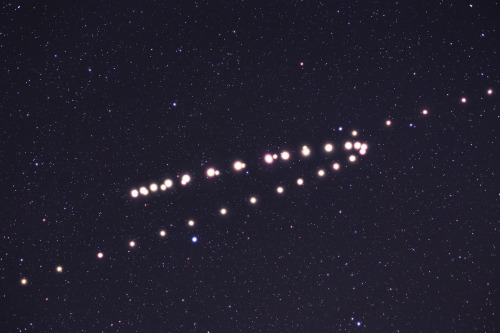
Retrograde motion of Mars in the night sky of the Earth.
Image Credit: Tunc Tezel

AI USED TO SHOW HOW HYDROGEN BECOMES A METAL INSIDE GIANT PLANETS
Researchers have used a combination of AI and quantum mechanics to reveal how hydrogen gradually turns into a metal in giant planets.
Dense metallic hydrogen – a phase of hydrogen which behaves like an electrical conductor – makes up the interior of giant planets, but it is difficult to study and poorly understood. By combining artificial intelligence and quantum mechanics, researchers have found how hydrogen becomes a metal under the extreme pressure conditions of these planets.
The researchers, from the University of Cambridge, IBM Research and EPFL, used machine learning to mimic the interactions between hydrogen atoms in order to overcome the size and timescale limitations of even the most powerful supercomputers. They found that instead of happening as a sudden, or first-order, transition, the hydrogen changes in a smooth and gradual way. The results are reported in the journal Nature.
Hydrogen, consisting of one proton and one electron, is both the simplest and the most abundant element in the universe. It is the dominant component of the interior of the giant planets in our solar system – Jupiter, Saturn, Uranus, and Neptune – as well as exoplanets orbiting other stars.
At the surfaces of giant planets, hydrogen remains a molecular gas. Moving deeper into the interiors of giant planets however, the pressure exceeds millions of standard atmospheres. Under this extreme compression, hydrogen undergoes a phase transition: the covalent bonds inside hydrogen molecules break, and the gas becomes a metal that conducts electricity.
“The existence of metallic hydrogen was theorised a century ago, but what we haven’t known is how this process occurs, due to the difficulties in recreating the extreme pressure conditions of the interior of a giant planet in a laboratory setting, and the enormous complexities of predicting the behaviour of large hydrogen systems,” said lead author Dr. Bingqing Cheng from Cambridge’s Cavendish Laboratory.
Experimentalists have attempted to investigate dense hydrogen using a diamond anvil cell, in which two diamonds apply high pressure to a confined sample. Although diamond is the hardest substance on Earth, the device will fail under extreme pressure and high temperatures, especially when in contact with hydrogen, contrary to the claim that a diamond is forever. This makes the experiments both difficult and expensive.
Theoretical studies are also challenging: although the motion of hydrogen atoms can be solved using equations based on quantum mechanics, the computational power needed to calculate the behaviour of systems with more than a few thousand atoms for longer than a few nanoseconds exceeds the capability of the world’s largest and fastest supercomputers.
It is commonly assumed that the transition of dense hydrogen is first-order, which is accompanied by abrupt changes in all physical properties. A common example of a first-order phase transition is boiling liquid water: once the liquid becomes a vapour, its appearance and behaviour completely change despite the fact that the temperature and the pressure remain the same.
In the current theoretical study, Cheng and her colleagues used machine learning to mimic the interactions between hydrogen atoms, in order to overcome limitations of direct quantum mechanical calculations.
“We reached a surprising conclusion and found evidence for a continuous molecular to atomic transition in the dense hydrogen fluid, instead of a first-order one,” said Cheng, who is also a Junior Research Fellow at Trinity College.
The transition is smooth because the associated ‘critical point’ is hidden. Critical points are ubiquitous in all phase transitions between fluids: all substances that can exist in two phases have critical points. A system with an exposed critical point, such as the one for vapour and liquid water, has clearly distinct phases. However, the dense hydrogen fluid, with the hidden critical point, can transform gradually and continuously between the molecular and the atomic phases. Furthermore, this hidden critical point also induces other unusual phenomena, including density and heat capacity maxima.
The finding about the continuous transition provides a new way of interpreting the contradicting body of experiments on dense hydrogen. It also implies a smooth transition between insulating and metallic layers in giant gas planets. The study would not be possible without combining machine learning, quantum mechanics, and statistical mechanics. Without any doubt, this approach will uncover more physical insights about hydrogen systems in the future. As the next step, the researchers aim to answer the many open questions concerning the solid phase diagram of dense hydrogen.
![[ @poppys ]](https://64.media.tumblr.com/ae61048bac2a087b8afc22622ce4abd3/f373f706315a89f8-df/s500x750/d6674e7c14f4868a95efe17a009bec666e471ca1.png)
![[ @poppys ]](https://64.media.tumblr.com/ea45ca5dd1f49368fabb938b4ce65c4e/f373f706315a89f8-69/s500x750/9c96bfe98532702324bbe79c0ec4d823bf02f21c.png)
![[ @poppys ]](https://64.media.tumblr.com/a411fc5c8ba90bfbb8cd771fb3dfc8a6/f373f706315a89f8-3c/s500x750/7294fa3443ec376740efdb094c672cb567b97bc0.png)
![[ @poppys ]](https://64.media.tumblr.com/46c0144abc8e12bc229c94b33dd27517/f373f706315a89f8-89/s500x750/a4fcaacc8526926b56ba57a1601a1a48ecc52764.png)
![[ @poppys ]](https://64.media.tumblr.com/5dd310df4ecab394eec3be9a3b782999/f373f706315a89f8-0d/s400x600/e1b14ea2eaf948cbf4769c80c75f673576d81eda.png)
[ @poppys ]









𝖒𝖔𝖔𝖓𝖘 𝖎

Three moons cast shadows on Jupiter.
Credit: NASA, ESA and E Karkoschka

-
 shitjaguar reblogged this · 1 month ago
shitjaguar reblogged this · 1 month ago -
 hunteroflostdreams reblogged this · 1 month ago
hunteroflostdreams reblogged this · 1 month ago -
 avenue1111 reblogged this · 1 month ago
avenue1111 reblogged this · 1 month ago -
 nnn-fuckyouthen reblogged this · 1 month ago
nnn-fuckyouthen reblogged this · 1 month ago -
 nnn-fuckyouthen liked this · 1 month ago
nnn-fuckyouthen liked this · 1 month ago -
 fuck-meee reblogged this · 1 month ago
fuck-meee reblogged this · 1 month ago -
 fuck-meee liked this · 1 month ago
fuck-meee liked this · 1 month ago -
 versoando liked this · 1 month ago
versoando liked this · 1 month ago -
 scorpiofeelingz reblogged this · 1 month ago
scorpiofeelingz reblogged this · 1 month ago -
 poxa-baixinha reblogged this · 1 month ago
poxa-baixinha reblogged this · 1 month ago -
 poxa-baixinha liked this · 1 month ago
poxa-baixinha liked this · 1 month ago -
 endringene reblogged this · 1 month ago
endringene reblogged this · 1 month ago -
 singrou reblogged this · 1 month ago
singrou reblogged this · 1 month ago -
 a-sentir-muito liked this · 1 month ago
a-sentir-muito liked this · 1 month ago -
 yourangel61 reblogged this · 1 month ago
yourangel61 reblogged this · 1 month ago -
 explodir-estrelas reblogged this · 1 month ago
explodir-estrelas reblogged this · 1 month ago -
 explodir-estrelas liked this · 1 month ago
explodir-estrelas liked this · 1 month ago -
 mind-blowing-freckles reblogged this · 1 month ago
mind-blowing-freckles reblogged this · 1 month ago -
 terrifyy reblogged this · 1 month ago
terrifyy reblogged this · 1 month ago -
 a-lonely-sunflower reblogged this · 1 month ago
a-lonely-sunflower reblogged this · 1 month ago -
 hunteroflostdreams reblogged this · 1 month ago
hunteroflostdreams reblogged this · 1 month ago -
 loesmer2 reblogged this · 1 month ago
loesmer2 reblogged this · 1 month ago -
 convocar reblogged this · 1 month ago
convocar reblogged this · 1 month ago -
 te-imaginando reblogged this · 1 month ago
te-imaginando reblogged this · 1 month ago -
 alxclira liked this · 1 month ago
alxclira liked this · 1 month ago -
 moonblueby liked this · 1 month ago
moonblueby liked this · 1 month ago -
 amor-em-junho reblogged this · 1 month ago
amor-em-junho reblogged this · 1 month ago -
 amor-em-junho liked this · 1 month ago
amor-em-junho liked this · 1 month ago -
 grimmmoirerobot liked this · 1 month ago
grimmmoirerobot liked this · 1 month ago -
 lostmindm reblogged this · 1 month ago
lostmindm reblogged this · 1 month ago -
 nor3mors3 reblogged this · 1 month ago
nor3mors3 reblogged this · 1 month ago -
 implodi-r reblogged this · 1 month ago
implodi-r reblogged this · 1 month ago -
 invernobipolar liked this · 1 month ago
invernobipolar liked this · 1 month ago -
 swupreme reblogged this · 1 month ago
swupreme reblogged this · 1 month ago -
 nuagedereves reblogged this · 1 month ago
nuagedereves reblogged this · 1 month ago -
 sintoso reblogged this · 1 month ago
sintoso reblogged this · 1 month ago -
 czsvo reblogged this · 1 month ago
czsvo reblogged this · 1 month ago -
 p4ssengers liked this · 1 month ago
p4ssengers liked this · 1 month ago -
 poeta-do-caos23 reblogged this · 1 month ago
poeta-do-caos23 reblogged this · 1 month ago -
 poeta-do-caos23 liked this · 1 month ago
poeta-do-caos23 liked this · 1 month ago -
 summariesofmylife reblogged this · 1 month ago
summariesofmylife reblogged this · 1 month ago -
 anatomiadaanna reblogged this · 1 month ago
anatomiadaanna reblogged this · 1 month ago -
 look-onmyworks liked this · 1 month ago
look-onmyworks liked this · 1 month ago -
 eximium reblogged this · 1 month ago
eximium reblogged this · 1 month ago -
 princelessnow reblogged this · 1 month ago
princelessnow reblogged this · 1 month ago -
 princelessnow liked this · 1 month ago
princelessnow liked this · 1 month ago -
 florescendointensidade reblogged this · 1 month ago
florescendointensidade reblogged this · 1 month ago -
 florescendointensidade liked this · 1 month ago
florescendointensidade liked this · 1 month ago
